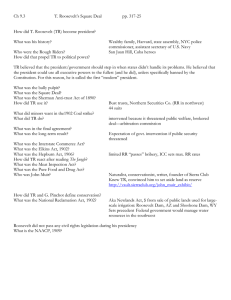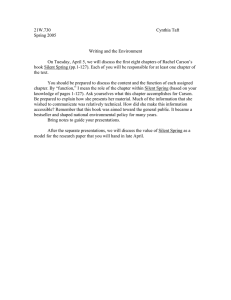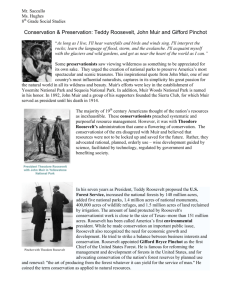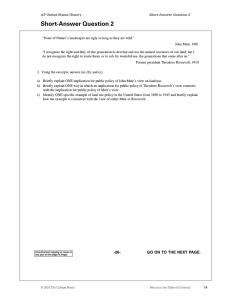Introduction to Environmental Science www.uidaho.edu/envs101
advertisement
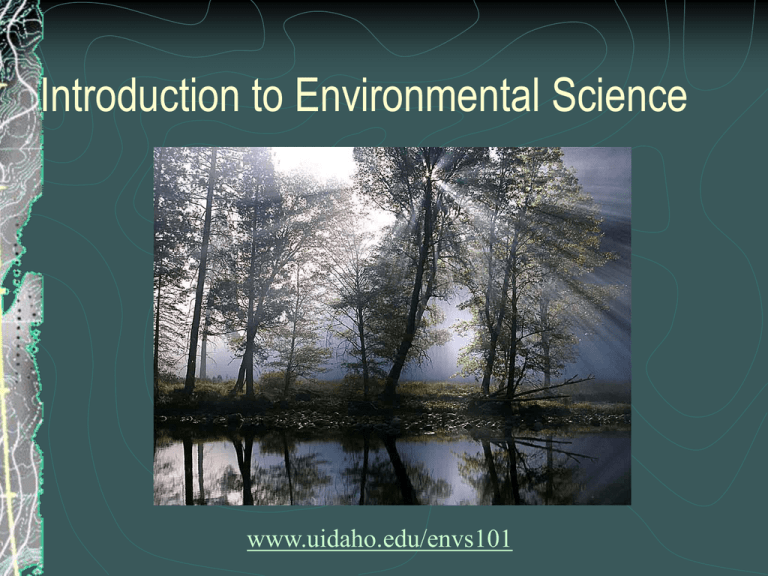
Introduction to Environmental Science www.uidaho.edu/envs101 What Is Environmental Science? Environmental Science is the study of how humans interact with their environment Our environment is everything that surrounds us, both natural and man-made. Man & His Environment Society at the dawn of the 21st century has many conveniences. Only 100 years ago no one owned a car, or computer or even a television. The world population of humans was about 1,500,000,000. In 1900, houses were still heated with coal or wood, there was no electricity and clothes were washed by hand in a large tub. Even then, man was having an impact on his environment, though much less dramatic than what was to come. Early Environmentalists President Theodore Roosevelt and naturalist John Muir were two of the first environmental activists. T. Roosevelt established the National Park System and the system of wildlife refuges found across the country. However much of the preservation system was based upon utilitarian conservation-the preserving of resources so they can provide homes and jobs for people. Early Environmentalists John Muir was a geologist, author and founder of the Sierra Club. Muir argued that nature deserved to exist for its own sake, regardless of its usefulness to us. His view was called altruistic preservationemphasizing the fundamental right of other organisms to exist and to purse their own interests. Natural Resources Muir and Roosevelt both saw the need to preserve natural resources Natural resources may be renewable such as solar energy and trees Natural resources may be non-renewable such as oil, natural gas or metals We must always be careful not to deplete renewable resources faster than they can be replaced, and to recycle and conserve nonrenewable resources. A Century of “Growth” The inventions of the twentieth century had a remarkable effect on daily life. They also had a devastating effect on the environment. Human population reached 6,000,000,000 in 1999 and continues to grow. In 1962 Rachel Carson wrote a ground-breaking book on what was happening to the environment. Her book was called “Silent Spring”. It became a warning to change our ways. “Silent Spring” The title of Carson’s book referred to the disappearance of songbirds due to the pollution of air and water. People were shocked by the severity of the problem. Carson’s book highlighted the effects of air and water pollution on humans and other species of animals. The Growth of Environmentalism In 1970, the first Earth Day was celebrated to honor the Earth and shine a light on the damage being done to her. Thousands of people turned out across the country for rallies and demonstrations to bring attention, both political and popular to environmental problems. Later that same year, 1970, the first Clean Air Act was voted into law which made factories legally responsible for cleaning up what gases are produced through their smokestacks. Scale of Environmental Problems Environmental problems are typically categorized by the affected population. Global problems, like global warming and the hole in the ozone layer affect the entire world population. It is important to note that even though the entire planet’s population is affected, the problems are caused by people living in the world’s richest countries. A World Apart Yes! You need this! More Money, More Consumers The countries which have more wealth also use more of the Earth’s resources. We also produce more of the substances which may damage the Earth The Good News With all that said however, it is important to note that the wealthiest countries have done much to address the world’s environmental problems. The U.S. for example has much better air and water quality than it’s poorer neighbor, Mexico. Typically these “poorer” countries have few environmental protection laws and many of the same problems. Scale of Environmental Problem Some of the problems we face are huge. The destruction of the world’s forests, the hole in the Earth’s ozone layer and global warming all seem like problems that are so big we cannot have an effect to change them. This is simply not true. All of the problems caused by man can be fixed by man. All it takes is the commitment to get it done and the knowledge it needs to be done. It is the goal of this class to give you that knowledge.
